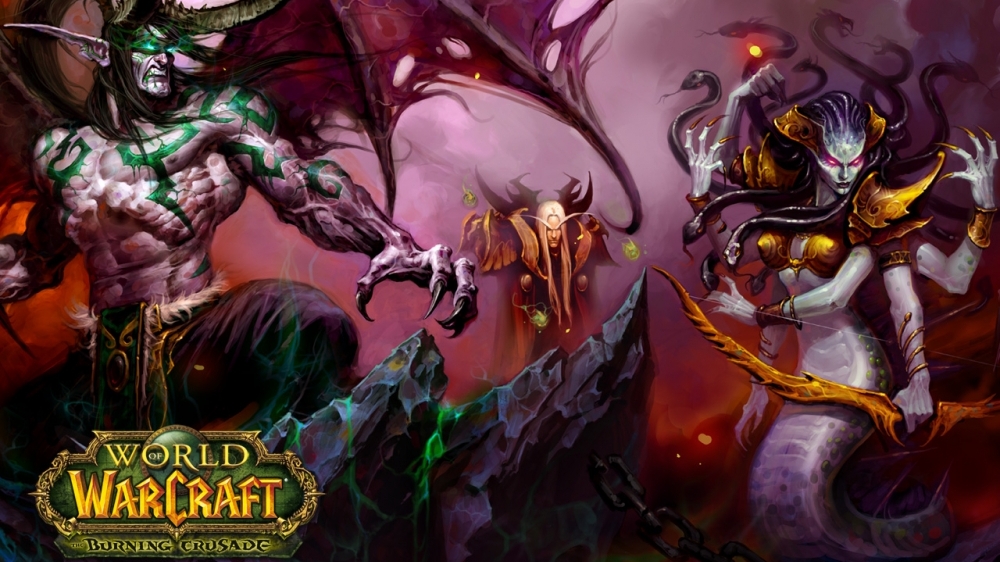With The Burning Crusade in early 2007, Blizzard not only brought well-known features such as two fresh races, Outland with all its challenges, or the profession of jewel cutting to the World of Warcraft. Even on a small scale, a lot has changed. In this special, we want to look at the differences that are relevant for combat compared to WoW Classic – it’s about the buff cap, new values, adjusted area damage and much more.
Anyone who hears WoW: The Burning Crusade will certainly immediately have iconic raid challenges such as the Black Temple or Karazhan in mind, mentally languish at Illidan’s war glaives or remember all the adventures experienced on Outland . All this and much more awaits us when Blizzard’s leaders provide classic servers for TBC for the first time or when they expand the existing WoW Classic servers with TBC content (as of today, we don’t know what Blizzard is planning).
But back then, with the launch of TBC and the subsequent patches in Azeroth, a lot had changed, even on a small scale. And if Blizzard – as with WoW (buy now) Classic – will use the latest patch 2.4.3 as the foundation of TBC Classic, all these small changes will affect our gaming experience from day 1. For this special we have therefore dug through the patch notes for you again and selected all the adjustments introduced with TBC that affect combat in PvE and PvP.
TBC Classic: Buff and debuff caps
In WoW Classic it’s been a big issue throughout all phases: players can only use a limited number of buffs at the same time before each new buff overwrites the oldest effect. The upper limit of the buffs is 32. And there is also a maximum upper limit for the weakening effects that affect an opponent, which is even reached at 16 debuffs. Both caps have a huge impact on the feel of Classic.
Anyone who has obtained all available world buffs in WoW Classic must be careful not to use too many consumables afterwards. In the worst case, a simple heal-over-time effect or a weapon proc could overwrite a powerful buff, for example from Dire Maul North.
In raids it is usually clearly defined which debuffs are allowed and which are not. Many ways of playing have to do without their damage-over-time effects, since they would only clean debuffs with their DoTs, which ultimately bring the raid significantly more.
With TBC Classic, the whole issue of buffs and debuffs will relax for the following reasons:
The world buffs from Classic were made uninteresting for level 70 characters with Patch 2.1, as they only work up to level 63.
Elixirs were split into Combat and Guardian Elixirs in patch 2.1. You can only use one Combat Elixir and Guardian Elixir at a time. If you throw in a flask, elixirs are not usable at all, since a flask is treated like a guardian and combat elixir.
Increased the cap on debuffs that can be applied to enemies simultaneously from 16 to 40 in TBC. Incidentally, the debuff cap only completely disappeared with WotLK in December 2008 .
TBC Classic: Everything is different with the values
With TBC and throughout the TBC era, Blizzard developers have made important adjustments to our characters’ stats. The biggest change right at launch: Items no longer provide a percentage increase in critical hit chance, hit chance, or dodge chance. Instead, the so-called “Combat Rating System” was introduced for all values.
The background to this change: The stat counters that you need to increase a stat by one percent change with your level. For example, if 28 points of critical hit rating at level 34 gives you maybe 4 percent more critical hit chance, then 28 points of critical hit rating at level 70 only give you 1.27 percent more critical hit chance. However, if you get a fixed 2 percent more critical hit chance from somewhere, for example through a talent or a buff, then it doesn’t matter whether you are level 34 or level 70, the bonus remains fixed at 2 percent more critical hit chance.
At level 70 the conversion to TBC looked like this:
15.77 melee hit rating = 1 percent more chance to hit
15.77 haste rating = 1 percent more haste (the value changed in TBC in the meantime and was then reset again)
12.62 Spell Hit Rating = 1 percent more spell hit chance
22.08 Critical Hit Rating = 1 percent more critical hit chance
5.92 armor penetration rating = 1 percent more armor penetration
2.37 defense rating = 1 point of defense
1 point Defense = 0.04 percent reduced chance to be critically hit and 0.04 percent increased chance to block/dodge/parry/miss
18.92 dodge rating = 1 percent dodge chance
23.65 parry rating = 1 percent parry chance (from patch 2.1, before it was 31.54 parry rating)
7.88 block score = 1 percent block chance
Up to patch 2.3: 3.9 weapon skill rating = 1 point of weapon skill
As of Patch 2.3: 15.77 Expertise rating = 4 Expertise = 1 percent less chance of the opponent to dodge or parry your punches
The removal of Weapon Skill with Patch 2.3, along with the simultaneous introduction of Weapon Expertise, had a major impact on numerous items, talents, and racial bonuses. There’s a good chance we’ll be dealing with Lore from the very beginning of TBC Classic.
Also new in TBC is the Resilience stat, which you’ll find primarily on PvP armor and weapons.
- 39.4 resilience rating = 1 percent resilience = 1 percent lower chance of being critically hit / 2.2 percent lower crit damage / 1 percent lower damage from players (DoTs are also affected as of patch 2.2) / 2.2 percent lower Amount of mana drained (as of patch 2.4)
Note that you can also use Resilience as a tank in PvE to make yourself immune to critical hits.
Important limits in TBC
As in WoW Classic, you want to reach certain thresholds in the TBC era before you focus on increasing other values. Here are the most important limits:
- Crit immunity for level 70 tanks when fighting raid bosses: 490 defense (you need 140 defense or 332 defense rating through equipment)
- Crit Immunity for level 70 tanks when fighting raid bosses through resilience: 5.6 percent resilience or 221 resilience rating
- Cap for spell hit chance on level 73 enemies (bosses): 16 percent or 201.92 spell hit chance
- Cap for spell hit chance in PvP (versus level 70): 3 percent or 37.86 spell hit chance
- Cap for melee hit chance on level 73 enemies (bosses): 9 percent (141.93 hit rating – applies to all abilities or to auto attacks with two-handed weapons/one-handed weapons plus a shield) and 28 percent (441.56 hit rating – applies to auto-attacks with two one-handed weapons)
- Cap for melee hit chance in PvP (versus level 70): 5 percent (78.85 hit rating)
- Expertise soft cap (level 73 enemies will no longer dodge your attacks if you’re behind them): 26 expertise or 101.92 expertise rating
What is WoW Classic?
World of Warcraft Classic is a true recreation of the original WoW as you know it from 2006. All parts of the game – from combat mechanics and talent trees to character models and zones – have been recreated, contributing to the authentic experience.
Getting Started
All players with an active World of Warcraft subscription or game time on their accounts have access toWoW Classic at no additional cost.
- Open the Blizzard Battle.net Desktop App and select World of Warcraft from the menu.
- Select World of Warcraft Classic from the Version menu. If you have more than one World of Warcraft account, you’ll see a second Account drop-down list. In this column, select the active account you want to play with.
- Click the Install button. The progress bar will tell you when your game is ready to play.
- Click the Play button when the installation is complete.
You will need to select the realm you want to play on from several different realm types. Make sure you choose the same realm as your friends – in World of Warcraft Classic, you can only group with characters that are on the same realm as you!
Heroes&WIKI, WoW Classic, World of Warcraft Classic, WoW ClassicSpecial, WoW ClassicSpecials






